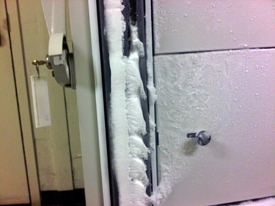News You Can Use
Freeze...But First Move Quickly
Replacing Energy-Guzzling Freezers Saves Research Dollars
Science at NIH is energy-intensive work in more ways than one. There’s around-the-clock labor. And then there’s the friendly neighborhood power plant providing the electricity to run all those instruments and machines…jokes about post-storm reliability aside.

Science is also expensive. The typical monthly PEPCO energy bill is in the $5 million range. A not-so-insignificant portion of this amount is due to freezer use. There are at least 2,400 freezers on the Bethesda campus alone. Nearly every lab has one and many have two.
Freezers usually are the greatest single-source users of electricity in the labs. An old and inefficient freezer could use as much electricity as a 2,500-square-foot house.
This past summer, however, the NIH replaced 98 old freezers with 70 new ones, a scheme that will save approximately $65,000 annually on energy costs. The purchases were part of an innovative program dreamt up by the NIH Office of Research Facilities (ORF), one of the offices that help keep this place running.
Because the winter of 2011–2012 was so warm, the NIH’s utility bill was lower than expected. Better yet, the ORF found a way to funnel the savings into research. The ORF allocated $685,000 to subsidize new freezer purchases by 50 percent. Labs accepted into the program contributed the matching funds.
That program—a huge success—is over. But if you want a new freezer at a discounted price, you aren’t completely out in the cold. The Office of Research Services (ORS) Division of Scientific Equipment and Instrumentation Services has negotiated a discounted, bulk-purchase price through the end of December 2012. The plan is to replace and even shed a few dozen additional freezers across the NIH.
What’s the incentive? For starters, lab space. Newer freezers are sleeker and better insulated than models built just a decade ago. A new 19.4-cubic-foot freezer can hold as much as an older 23-cubic-foot freezer, about a 20 percent space savings. With careful consolidation two old freezers can be replaced with one new one. Also, energy savings can translate directly into more money for research, in this case, the subsidized purchase of freezers that normally go for about $10,000 a pop.
If more freezers are replaced and more energy is saved—a combination of reduced electricity cost and reduced building cooling costs, because freezers generate so much external heat—NIH could save hundreds of thousands of dollars annually. In fact, Leo Gumapas of ORF’s Division of Environmental Protection, who helped initiate the freezer program, has taken the initial steps in monitoring the precise energy demands of these freezers.
Contact Annalie Burke from the ORS Scientific Equipment Rental and Sales Branch (burkea@ors.od.nih.gov or 301-496-9748) if you are interested in purchasing a new freezer. Dozens of labs that weren’t able to participate in the subsidized program signed up in recent months for “phase two,” the purchase of discounted freezers negotiated for FY2012. Now, these same prices will apply for “phase three” through calendar year 2012 if there is sufficient demand, Gumapas said.
The discounted prices include inside delivery, extended warranty, and preventative maintenance for the NIH main campus and Montgomery County lease facilities—options that otherwise would be costly.
This page was last updated on Friday, April 29, 2022
